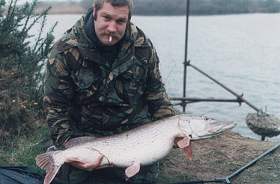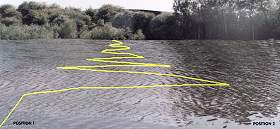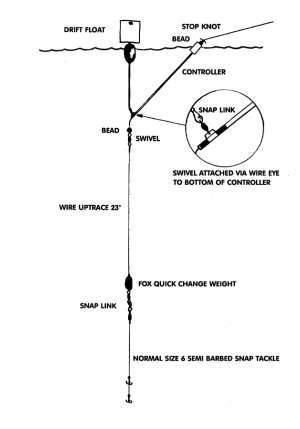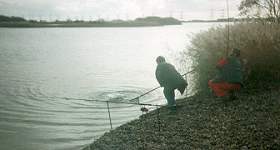The driftfloat is a very useful tool in the modern pike angler’s armoury. It is an effective tactic that is easily used and the equipment required is readily available. It is, unfortunately, a method that I see practised very badly on a regular basis, it’s true potential never being realised by most of its exponents. Considering the use of the drifter is not an everyday requirement in my fishing I do not proclaim to be an expert. However, I will say that if you try my approach it will certainly be a good starting point and you may be pleased with your results.
|
|
| drifting over a deep hole that lies beyond casting range |
First of all let’s look at when and why we should use the drifter. The most common way I see drifters being misused is by anglers just setting up anywhere with the wind behind them, casting out, and letting the float drift off into the wild blue yonder!
Yes, you cover a great distance, but how many pike do you cover? If you did this on one of my regular pike waters (a 40-acre pit) on most of the swims you would just be drifting the bait away from the pike! On another pit of a similar size though there is a deep hole just in front of an island that the pike regularly pack in to. At a distance of 80m it is not within casting reach with a live bait. The drifter soon takes your bait out there and once there you can hold it in place. If you know the features on your water then you can use the method in this way.
If you are unsure of the underwater features on your chosen water there is a good way to cover the maximum amount of water from your swim. Set up two rod rests a sensible distance apart. This will depend on the bankside features and any other anglers on the water. An ideal distance is about 30-40 foot.
Cast out and place the rod on the first rest with the bale-arm open. If you are just using the one rod you can obviously just hold it. Holding the rod means you can control the drift much better. Sometimes one well-fished rod is better than several poorly fished. This is especially true in very strong winds.
|
|
| A lot of water can be covered very effectively. |
Once the float has travelled out 10ft or so, stop it from drifting, and just let it hold and fish in the area for a time (I like 15 to 20 minutes but it can be varied). Once the time is up undo the bale-arm and walk to the second rest/position, paying out line as you go. Once there close the bale-arm and the float will drift around covering a lot of area until it is stationary. Leave it to fish the area for a period of time before moving back to the first position with the bale-arm off and paying out line. The process is obviously repeated until the end of the drift or a fish is contacted. As you can see from the diagram this ‘zigzagging’ method covers a lot of ground.
|
|
| |
The only other way that I use the drifter is when boat fishing! This may sound a bit strange, but allow me to explain. The only really safe bite indication method when bait fishing from a boat is the good old float. The problem is that floats have to be watched! You often see a pair of anglers fishing up to six rods between them from the boat. These floats are spaced out all around the boat and are often not correctly watched. Sat back to back the two anglers can see all of the floats between them. This is fine on a calm day but as soon as the wind gets up all six floats start to blow around down wind of the boat! As well as the resulting tangles it is now pointless using all of the rods as they are all in the same area and offer you no advantage. You can, however, if you include two drifter set-ups, use four between you. The drifters can be sent downwind to different distances and the standard two rigs fished of opposite sides of the boat in the available downwind space. More area is covered and all floats can easily be seen due to them being in the same direction.
Let’s now take a look at the tackle needed for this method. Not too many years ago I would be now be writing about huge reels and powerful 13ft fast taper rods. With the availability of the modern braided lines all this is now, to a certain extent, redundant. With their thin diameters and virtually no stretch, the braided lines mean that your normal pike rods and reels will now be up to controlling your rig and setting the hooks at extreme ranges. I still like a 13ft rod but it is certainly no longer essential. The other great property about braid is that it floats. Prior to braid we used to have to grease the nylon to keep it floating, a messy and ongoing task. It is of great importance that the line floats. First of all if your main line sinks it will just act as a giant anchor and stop the float moving. Secondly the sunken line can easily become snagged. Lastly and most importantly the sunken line can become entangled with the bait, especially a live one, and this can obviously result in a bite off.
|
|
| See Tackle Workshop |
As for the driftfloat itself look at my Tackle Workshop article and you can see how to make one in words and pictures. Other than the vane attachment system my floats are just a copy of the original ET driftfloats. I do, however, build different sizes to support different size baits. As with any float, different colours show up better in different light conditions. I find carrying a selection of homemade vanes in yellow, orange and black covers all situations.
One of the only problems I have encountered with braid is that due to its suppleness it tangles easily around the float. This problem seems to be more apparent in calmer conditions. The standard way to overcome this is by using a controller. Once again how to make these is shown in the Tackle Workshop.
The controller not only acts as an anti-tangle tube but also helps stop the first foot or so of the braid being drowned due to the bottom end only method of attachment. This avoids a lot of the tangles in most situations. Large livebaits in calm conditions can still be a pain. For the last couple of seasons I have been developing (Sorry, that sounds a bit grand for such a simple idea!) another method to avoid tangles, I call this a ‘Drifting Leader’. All it consists of is a length (3 to 5ft – not decided which is best yet) of level floating fly line attached between the braid mainline and the rig. This acts as an anti-tangle device as it both floats high and keeps the braided mainline away from the float. Being quite stiff it does not tangle itself.
|
|
| |
If you want to try this the best way is to contact a fly fishing specialist shop and purchase either a level floating fly line (hard to get these days). Alternatively a floating running line (which is used to replace worn running lines on weight forward fly lines) fits the bill. If you have no luck with either of these you will have to buy a cheap fly line or cut off the lengths you need. One line would give lifetimes supply of leaders for you and your mates.
For the actual rigs I use please see the diagrams. You will notice that I always use an up trace and fixed leads. This is essential to avoid bite-offs if you are using livebaits. Sliding leads also allow the bait to swim up to the surface and tangle with the main line. You may have noticed my constant mention of livebaits, these are my preference but deads (especially naturals) also work very well when drifted. The clip and Arseley bomb method is great for the quick changing of weights to suit different baits.
So nothing too revolutionary there but as I first said a good starting point for you to develop your own version of this fun and some times productive tactic.
My last word on the subject is that as with all types of float fishing that float must be watched! Instant striking and barbless trebles are as much use in avoiding deep hooking as an ashtray on a motor bike if you don’t constantly watch that float!
Send your tackle making requests and repair advice to Tackle Workshop. And if you have a good tip for making tackle we’ll be very pleased to hear about that too.
Send them to graham@fishingmagic.com
Steve ‘Budgie’ Burgess, along with his partner Luke Moffatt, run the highly successful European Catfish Trips.
If you’re interested contact Budgie for information on Spain, or contact Luke for information on France and Italy.
Budgie Burgess
Tel: 01797 321618
Email: BUDGIE@burgess23.fsnet.co.uk
Luke Moffatt
Tel: 01895 835745
Fax: 01895 835265.















